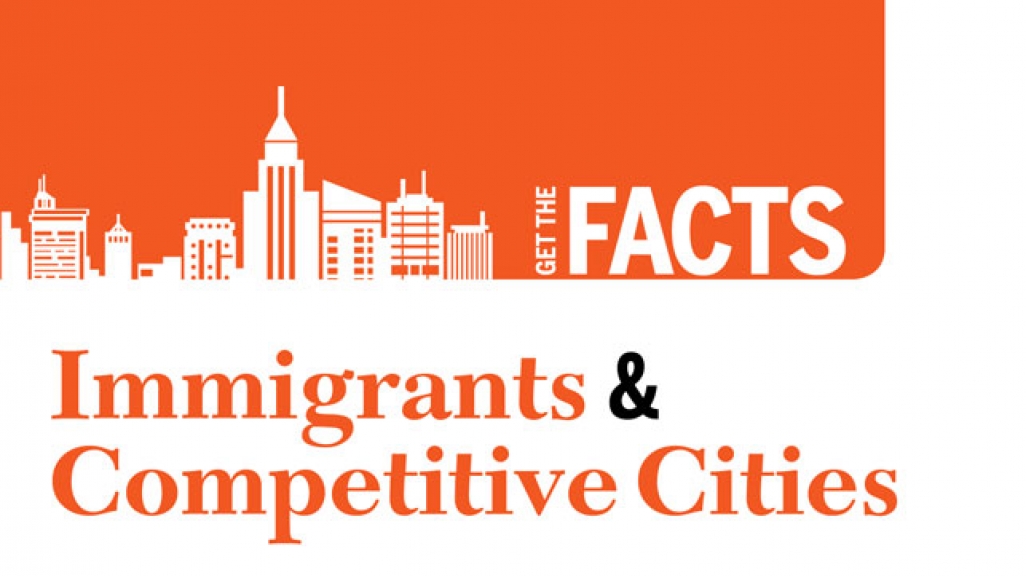Get the Facts: Five Ways Immigrants Make Cities More Economically Competitive
Get the Facts: Five Ways Immigrants Make Cities More Economically Competitive
Despite uncertainty over the fate of immigration reform in U.S. Congress, immigrants continue to be the economic engine of cities across the country.
Even with the uncertainty over the fate of comprehensive immigration reform in Congress this spring, immigrants continue to be the economic engine of cities across the country. This fact sheet—the eighth in our series on immigrants and the economy—details five reasons why immigrants play a vital role in creating economically vibrant, competitive cities.
- Download a PDF of the fact sheet.
- Access AS/COA’s Get the Facts series at: www.as-coa.org/immigration-facts.
Five Ways Immigrants Make Cities More Economically Competitive
1. Immigrants contribute to a dynamic labor force and spur economic growth.
- In St. Louis, the average foreign-born resident contributes 29 percent more to the region’s income than the average U.S.-born resident due to wage earnings and labor force participation rates. [1]
- In several metropolitan areas, the addition of immigrants to the labor force contributed to economic growth. In Atlanta, the immigrant share of the labor force increased from 4.6 percent to 16.4 percent between 1990 and 2007, while the economy grew by 84 percent over the same period. [2]
- Dallas, Houston, and Phoenix, the metropolitan areas with the fastest economic growth during that same period, also experienced the greatest increase in the immigrant share of the labor force compared to other cities. In contrast, Cleveland, Detroit, and Pittsburgh, the metropolitan areas with the smallest immigrant share in their labor forces, experienced the slowest economic growth. [3]
2. Immigrants are more likely to start businesses and create jobs in their cities.
- In Baltimore, foreign-born residents own nearly 21 percent of small businesses, despite representing just 9 percent of the population. [4]
- In the St. Louis, Missouri region, immigrants are 60 percent more likely to be entrepreneurs than U.S.-born residents. If St. Louis expanded immigration inflows by 4 percent, the unemployment rate for African Americans in the city would be reduced by 2.5 percent. If the city added 20,000 immigrants, an additional 21,600 workers would be employed. [5]
- As of 2011, 135 foreign-owned companies created more than 34,000 jobs in Nashville. [6]
- Between 1970 and 2010, immigrants helped create or preserve 45,000 manufacturing jobs in Harris County, Texas, which includes Houston and the surrounding suburbs. [7]
3. Immigrants are critical to helping cities counteract population decline, keeping economies vibrant and strong.
- The 6,500 immigrants who settled in Duplin County, North Carolina since the 1980s have helped reverse population decline and boost property values. [8]
- Immigrants revitalized the city of Utica, New York, representing 95 percent of its population growth between 2000 and 2010. [9]
- The inflow of nearly 600,000 immigrants to Chicago and surrounding Cook County, Illinois since 1970 helped offset the departure of 900,000 U.S.-born residents. [10]
4. Immigrants make cities more attractive by raising housing values.
- Immigrants have added value to the average home in some of the most populous cities and counties across the U.S., including Mecklenburg, North Carolina ($5,923); Philadelphia, Pennsylvania ($4,084); Cobb County, Georgia ($3,779); Baltimore, Maryland ($3,285); St. Louis, Missouri ($2,252); and DeKalb County, Georgia ($1,197).
- For every 1,000 immigrants settling in any given county, 270 U.S.-born individuals follow, drawn by the increased economic opportunities created by immigrants. [11]
- Immigrants have helped stabilize the housing market in less desirable communities, making these communities more attractive options for prospective American homeowners. For example, in the greater Chicago metro area, the arrival of 13,000 new immigrants in nearby Gary, Indiana since 1990 added $1,500 to the value of the average home. [12]
5. Higher levels of education among immigrants contribute to a talented workforce.
- In the Charlotte metro area there were over 2,200 requests for H-1B visas between 2010 and 2011. [13] These high-skilled jobs create the need for additional supportive and complementary jobs, benefiting the local metro area.
- In Baltimore, 44 percent of the immigrant population has earned a college degree, compared to 32 percent of their U.S.-born counterparts. [14]
This fact sheet is a product of the AS/COA Integration and Immigration Initiative, which advances the integration of immigrants and promotes positive dialogue around the economic contributions of immigrants across the United States. It was produced by Leani García, policy associate, in collaboration with Kate Brick, policy manager; Richard André, senior policy associate; and Rebecca Bintrim. For media inquiries or to speak with an expert on this topic, please contact Adriana La Rotta in our communications office at: alarotta@as-coa.org.
Editor's Note: This publication previously stated in error that Atlanta's economy grew 87 percent from 1990 to 2007. It grew by 84 percent.
[1] Jack Strauss, “The Economic Impact of Immigration on St. Louis,” St. Louis University, 2012, p.4.
[2] “Immigrants and the Economy: Contribution of Immigrant Workers to the Country’s 25 Largest Metropolitan Areas, with Detail on the Five Largest Metro Areas in the East,” Fiscal Policy Institute, 2009, p.9.
[3] Ibid., p.8.
[4] Immigration Research Initiative, “Immigrant Small Business Owners: A Significant and Growing Part of the Economy,” Fiscal Policy institute, 2012, p.22.
[5] Jack Strauss found a correlation between immigration inflows and a reduction in the unemployment rate for African Americans in St. Louis by using city data from the Census, Bureau of Labor Statistics and Bureau of Economic Affairs in statistical equations. Jack Strauss, “The Economic Impact of Immigration on St. Louis,” Saint Louis University, 2012, pp.21, 35-36,41.
[6] Nashville Area Chamber of Commerce, “Nashville International Business Brochure.”
[7] Jacob L. Vigdor, “Immigration and the Revival of American Cities: From Preserving Manufacturing Jobs to Strengthening the Housing Market”, Partnership for a New American Economy and Americas Society/Council of the Americas, 2013, p.9.
[8] Jason Marczak, “Immigrants Boost U.S. Economic Vitality through the Housing Market,” Americas Society/Council of the Americas and Partnership for a New American Economy, 2013.
[9] Smart Growth Needs Immigrants; Immigrants Need Smart Growth in New York, Empire State Future, 2012.
[10] Jason Marczak, “Immigrants Boost U.S. Economic Vitality through the Housing Market,” Americas Society/Council of the Americas and Partnership for a New American Economy, 2013.
[11] Jacob L. Vigdor, “Immigration and the Revival of American Cities: From Preserving Manufacturing Jobs to Strengthening the Housing Market,” Americas Society/Council of the Americas and Partnership for a New American Economy, 2013, pp.2-3.
[12] “Ibid., p.17.
[13] Neil G. Ruiz, Jill H. Wilson and Shyamali Choudhury, “The Search for Skills: Demand for H-1B Immigrant Workers in U.S. Metropolitan Areas” Brookings Institute, 2012.
[14] Rachel Friedberg and David Jaeger, “The Economic Diversity of Immigration Across the United States,” Institute for the Study of Labor, 2009, p.44.








